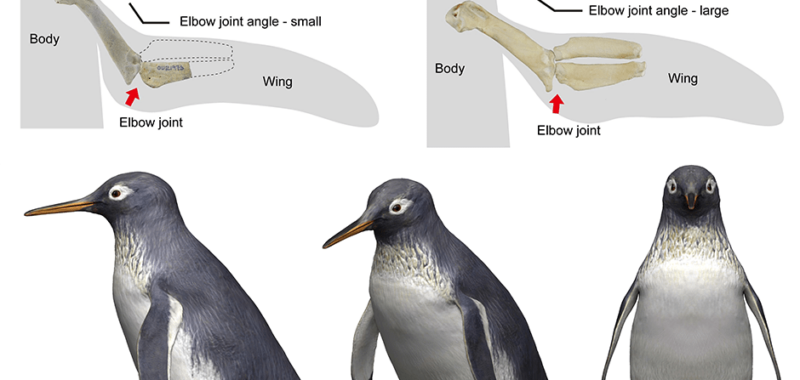Penguins can’t fly. And while their wings may seem to be purely decorative, these appendages actually play a larger role in their evolutionary history. A fossil penguin species named Pakudyptes hakataramea bridges a gap between penguins that have gone extinct and those living today. Some of its bones show how these wings evolved to help penguins become such speedy swimmers. The findings are described in a study published July 31 in the Journal of the Royal Society of New Zealand.
Pakudyptes lived in present-day New Zealand’s South Island about 24 million years ago. It was very small, roughly the same size as the little blue penguin–or kororā living today. At only 9.8 inches tall and 2.2 pounds, Pakudyptes are among the smallest known penguin species to ever live on Earth.
[Related: This human-sized penguin isn’t even the largest ancient penguin we know about.]
Interestingly, Pakudyptes did have the physical adaptations that allowed them to dive into the water, despite being such an early penguin species. In the study, a team of scientists from the University of Otago in New Zealand, and Japan’s Ashoro Museum of Paleontology, Okayama University of Science, and Osaka University examined three bones. The humerus, femur, and ulna were discovered during several field trips in 1987 by the late paleontologist Ewan Fordyce in the Hakataramea Valley, in the Canterbury region of the South Island.
They found that Pakudyptes fills in a morphological gap between modern and fossil penguins who are now extinct.
“In particular, the shape of the wing bones differed greatly, and the process by which penguin wings came to have their present form and function remained unclear,” study co-author and Ashoro Museum of Paleontology paleontologist Tatsuro Ando said in a statement.
The humerus and ulna bones show how the penguins’ wings have evolved.
“Surprisingly, while the shoulder joints of the wing of Pakudyptes were very close to the condition of the present-day penguin, the elbow joints were very similar to those of older types of fossil penguins,” said Ando. “Pakudyptes is the first fossil penguin ever found with this combination, and it is the ‘key’ fossil to unlocking the evolution of penguin wings.”

Otago’s Faculty of Dentistry analyzed the fossil’s internal bone structure alongside data on living penguins from the Okayama University of Science. They found that Pakudyptes had microanatomical features that suggest they could dive. Modern penguins are well known for their excellent swimming abilities. Their bullet-like swimming skills are largely due to the dense, thick bones that add to their buoyancy during diving.
In Pakudyptes, the bone cortex was reasonably thick. However, the medullary cavity–which contains bone marrow–was open. This is similar to the living little blue penguin, which usually swims in shallow waters.
Pakudyptes’ diving and swimming likely comes down to the distinctive combination of its bones. The humerus and ulna show spots for attachment of muscles and ligaments, which reveal how the wings were used to swim and move underwater.
[Related: Poop stains reveal four previously unknown Emperor penguin colonies.]
While no longer living, fossil penguins were usually large. Some could reach about 4.5 feet or even 6 feet tall, compared to today’s Emperor penguins that clock in at about three to four feet.
“Penguins evolved rapidly from the Late Oligocene to Early Miocene and Pakudyptes is an important fossil from this period,” study co-author Carolina Loch from Otago’s Faculty of Dentistry said in a statement. “Its small size and unique combination of bones may have contributed to the ecological diversity of modern penguins.”

